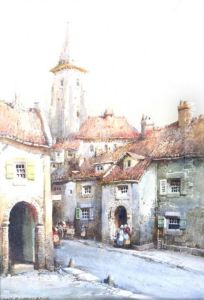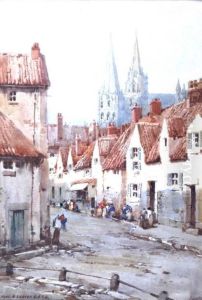Noel Henry Leaver Paintings
Noel Henry Leaver was a British artist, best known for his watercolour landscapes and architectural paintings. Born in Austwick, Yorkshire, on December 24, 1889, Leaver's early life set the stage for a prolific career in the arts. He showed an early interest in drawing and painting, which led him to pursue formal education in the field. Leaver attended the Halifax School of Art, where he honed his skills and developed a distinctive style that would later become highly sought after. His talent was recognized early on when he won a scholarship to the Royal College of Art in London, an achievement that marked the beginning of his professional journey.
Leaver's work is characterized by its detailed depiction of architectural features and a masterful use of light and shadow, often bringing a dramatic sense of atmosphere to his scenes. His subjects ranged from British landscapes and cityscapes to scenes from his travels abroad, including the Middle East and Europe. Despite the variety in his subjects, Leaver maintained a consistent quality and style throughout his career, earning him a place among the notable British watercolourists of the 20th century.
Throughout his career, Leaver exhibited his work widely, including shows at the Royal Academy and the Royal Watercolour Society. His paintings were well received by critics and the public alike, and he quickly gained a reputation for his skillful landscapes and architectural paintings. In addition to his painting, Leaver also dedicated part of his career to education, teaching at the Harris Institute in Preston for many years. His influence extended beyond his own work, as he mentored a generation of artists, imparting his knowledge and passion for watercolour painting.
Noel Henry Leaver passed away on July 17, 1951, leaving behind a legacy of art that continues to be admired. His work is held in numerous collections and galleries across the United Kingdom, ensuring that his contributions to British art are not forgotten. Leaver's dedication to his craft and his ability to capture the essence of his subjects in watercolour have cemented his place in the history of British art.

